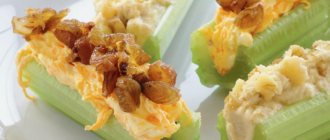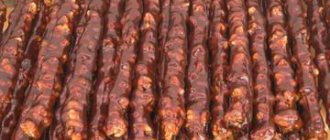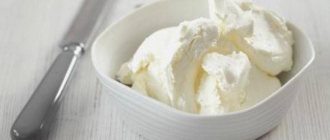Properties of tkemali sauce
Nutritional value and composition | Vitamins | Minerals
How much does tkemali sauce cost (average price for 1 jar)?
Moscow and Moscow region.
57 rub.
Tkemali sauce is truly the hallmark of Georgia. Without it, local residents simply will not sit down at the table, as they are sure that food without tkemali becomes incomplete. When they say tkemali, it immediately becomes clear that we are talking about a real signature sauce.
In general, tkemali sauce comes in 2 colors with various shades. For example, red (more piquant and sour) is obtained from red and yellow plums, and the green tint of the sauce, which is much sweeter, comes from the addition of sloe. An obligatory companion to the classic tkemali sauce is a seasoning with the rather mysterious name ombalo. Interestingly, this is a type of mint that grows exclusively in Georgia and it is this mint, in combination with sour plum, that gives the sauce such a unique taste. In other countries, this herb is often replaced with peppermint or lemon balm, only in this case it is a completely different culinary story.
It is known that sour plums contain a huge amount of pectin and tannins, which has a beneficial effect on the absorption of meat products. Georgians claim that clean air, combined with wine and tkemali sauce, is the secret of the longevity of the local elders.
In almost every Georgian yard you can see one or two plum trees. Each housewife cooks tkemali sauce according to her own unique recipe, so there are exactly as many recipes for preparing this dish as there are housewives in Georgia.
When preparing tkemali sauce, you should keep in mind that during the heat treatment the berries are boiled down 4 times. That is, to obtain a kilogram of sauce, you need four kilograms of sour plums. By the way, if you replace plums with tomatoes, you can get a completely different sauce - satsibeli, which also belongs to traditional Georgian dishes.
Tkemali sauce is ideal for any meat and fish dishes, vegetables and potatoes, spit chicken, pasta and bread. This sauce is usually served with meat and fish with chopped fresh dill and parsley, which is placed separately and added to taste.
Medicinal use
The use of cherry plum for medicinal purposes is justified. It helps people who suffer from constipation because it can have a slight laxative effect. As indicated in the folk recipe, for this case you will need to prepare a decoction of the fruit.
You can take fresh or dried, in the first case you need 200 grams, in the second - 3 tbsp. Fill with water and set to boil for 5 minutes, then everything should brew for several hours. Drink a glass three times a day.
There is a folk recipe based on the flowers of this plant that helps in treating the liver. 20 grams of this raw material are poured with 200 grams of boiling water and allowed to brew for 2 hours. Then you need to strain, consume 100 grams 2 times a day.
To treat colds and coughs, you will need 40 grams of crushed bark or roots, which should be poured into 1 liter of water and boiled for 7 minutes. Drink 100 grams throughout the day.
Composition of tkemali sauce
The main component of tkemali sauce, as mentioned earlier, is wild plum, which we call cherry plum and has a red, yellow or green color. In addition, the obligatory ingredients in this rich sauce are garlic and some types of aromatic herbs, in particular ombalo. This spice is added not only for the smell, but also to avoid the process of fermentation of plums during cooking.
Today, there are many modifications of this sauce, which is traditionally based on sour plum. So, often in the composition of tkemali sauce you can see natural substitutes for this berry - mainly red currants and gooseberries, which also have a rather sour taste.
Description of the plant
The fruits look like a small plum; they are also called cherry plums. They grow on thorny and branchy bushes and trees. Their shoots are brownish green in color. Plants, depending on the variety, can grow up to 10 meters in height - the tallest, and the shortest - 3 meters. The leaf has an upwardly pointed ellipsoidal shape.
Flowering time is the end of March. Flowers are single pink or white. On average, the diameter of rounded fruits reaches 2.5 cm.
Useful properties of cherry plum
Cherry plum contains a large amount of vitamins and minerals necessary for humans, so it is recommended to eat it every day for both children and adults.
The benefits of cherry plum are as follows:
- Promotes recovery from inflammatory processes
. Thanks to a large amount of vitamins, cherry plum strengthens the immune system and helps the body fight viruses and bacteria. - Treats diseases of the stomach, duodenum and intestines
. This berry stimulates the activity of these organs, while having a slight laxative effect, which is why it is recommended to eat it on an empty stomach. You can also use cherry plum for chronic constipation using an infusion of berries. - Strengthens the heart muscle
. The potassium contained in cherry plum has a positive effect on the functioning of the heart. - Is a bouquet of vitamins
. Cherry plum does not contain much sugar, so it can be consumed by those who suffer from diabetes. - Reduces swelling
. Due to the substances contained in cherry plum, excess liquid is not retained in the body. - Normalizes the functioning of the circulatory system
. Eating this berry helps strengthen blood vessels, increases hemoglobin and lowers blood pressure. - Treats problems in men
. Thanks to vitamins and macroelements, it treats impotence in the stronger sex. - Strengthens the immune system
. These berries are useful for diseases of the upper respiratory tract, coughs and colds. Cherry plum flowers are used to prepare an infusion, which is taken in the presence of these symptoms. Due to the large amount of vitamins, these berries should be eaten if you have vitamin deficiency. - Cleanses the body of toxins, waste and poisons
. It is recommended to use cherry plum for those people who live in contaminated areas. - Fights excess weight
. These berries are an excellent component of various diets and help you lose weight due to the fact that they contain little sugar. - Improves mood
. Eating cherry plum calms the nerves, relieves depression, and helps with insomnia thanks to the vitamins A and C contained in this berry.
In addition, cherry plum helps with diseases of the genitourinary system and kidney ailments, with problems with the liver and gall bladder.
It should be noted that fresh cherry plum is most useful. If you make juice from the berries, you can drink it to quench your thirst. This drink also gives strength and tones the body.
Not only berries are useful, but also cherry plum seeds. They make oil, which is no worse in composition than almond oil. The shells from the seeds are also not thrown away; they are used to clean food products.
Collection, consumption and storage
Despite the low calorie content of cherry plum, it should be consumed in moderation. This will avoid causing negative consequences. Fresh cherry plum must be properly collected, consumed and stored:
- The fruits need to be collected in 2-3 doses, since their ripening on trees occurs gradually.
- Collection must be done in dry weather. The fruits are picked with stalks for better preservation.
- If the berries are picked unripe, then ripening will take place in the refrigerator.
- If the cherry plum has been removed with its stalks, it can be stored in the refrigerator for up to 2 weeks.
- The fruits are frozen and dried. In the first case, they are stored for up to 1 year, and in the second – for up to 2 years.
- Cherry plum goes well with various products. There are dishes in which meat, poultry, fruits, vegetables, cheese and cottage cheese are added along with fruits.
Contraindications and harm when consuming cherry plum
Like any berry, “small plum” is not useful for all people.
Despite such a long list of beneficial properties, there are still some contraindications to cherry plum. But their list will be much shorter. Situations in which it is not recommended to use cherry plum:
- With increased acidity of gastric juice. These berries will irritate the gastric mucosa, which already suffers from a large amount of acid.
- Patients with peptic ulcer of the digestive organs. With this disease, patients must eat strictly permitted foods, and our berries should not be eaten due to their high acidity, so as not to irritate existing ulcers.
- For a person with individual intolerance to “small plums”. After all, even healthy people may experience side effects if they abuse the berry: poisoning and heartburn.
Application
Cherry plum fruits are used fresh and canned. From them I make preserves, jams, sauces, compotes, jam, jelly, marmalade, juice, wine. It is from cherry plum that the delicious and very healthy Tkemali sauce is prepared. Essence for lemonades is made from cherry plum juice. But you should not overuse cherry plum, otherwise it can cause heartburn.
Citric acid is produced from unripe cherry plum fruits. From the seeds, an oil is obtained that is similar in quality to almond oil, which is widely used in cosmetology, perfumery, and is used to make medicinal soap.
Market Analytics
- COVID-19 is changing the rules of the game in the cosmetics market
- Beauty of the future: cosmetic innovations 2020
- New ingredients are the driving force of the cosmetics industry
Convenient search for beauty salons on our website
Beauty salons in Moscow Beauty salons in St. Petersburg Beauty salons in Ekaterinburg Beauty salons in Novosibirsk
Latest blog posts on our website
- Naturecream / Geranium (Pelargonium) oil for skin health and beauty
- Prostye-sovety / Save on a beauty salon: procedures that can be done at home
- Naturecream / Growth Factor - brings back youth?
- Oksana-Lezina / 3 effective abdominal exercises from a fitness instructor for beginners
- Prostye-sovety / Making perfect curls at home
- Prostye-sovety / Which hair removal method to choose
- Naturecream / Wrinkles Puppets
- Naturecream / PEPHA-TIGHT - instant skin lifting
- Naturecream / Blue light - a danger to the skin
- Naturecream / Cocoa Butter – A treat for the skin
Latest forum topics on our website
- Mrs._Smith / Badly sunburned! What to do?((
- Ice / Is it necessary to combine fitness classes with a diet?
- Antonova / What can be used for hair loss?
- Radio operatorKat / Who was on a protein diet?
- Suzanna / Mesotherapy on the face
Other articles in this section
| Strawberry Strawberry is a herbaceous plant and reaches a height of about 35 cm. Strawberry fruits are false berries, which are an overgrown receptacle. The color of the berries, depending on the variety, can be all shades of red, the shape is predominantly conical, the flesh is tender, juicy, incredibly tasty and aromatic. |
| Rambutan Rambutan is a tropical fruit from the Sapindaceae family, a relative of lychee and longan. The fruits are round in shape and up to 6 cm in diameter, growing in clusters of 25-35 pieces. Ripe fruits have a dense red-brown skin, covered with a large number of hard, crocheted hairs at the ends. The food used is white or milky pulp with a jelly-like consistency, inside of which there is a large oblong bone. The pulp of rambutan is juicy, sweet, with a slight sourness and a pleasant aroma. |
| Sea buckthorn Sea buckthorn is a shrub or small tree, reaching a height of 3 meters, the branches are covered with small thorns and densely located fruits on short stalks. The fruits of the plant are small oval berries of yellow-orange color with a refreshing sweet and sour taste and a pleasant aroma, vaguely reminiscent of pineapple. |
| Mulberry The mulberry or mulberry tree is a valuable plant that supplies raw materials for many industries. Musical instruments are made from the wood; silkworms feed on the leaves of the tree, from whose cocoons natural silk is obtained. Mulberry fruits are small, fleshy, oblong berries. They are very tender, juicy, have a pleasant aroma and sweet taste. The color of the berries depends on the variety and can range from white to dark purple. Colloquially, there are “white”, “red” and “black” mulberries. |
| Apricot Apricot fruits have tender and juicy pulp, pleasant to the taste, perfectly quench thirst and hunger, and enrich the body with vitamins and microelements. The famous ancient scientist and healer Ibn Sina believed that apricots should definitely be in the diet of every woman, because eating these fruits gives the skin freshness and elasticity, strengthens hair and nails, and helps fight excess weight. |
| Cherimoya The cherimoya fruit has a rounded conical shape, a complex segmented structure and weighs from 200 g to 2 kg. It has aromatic, juicy, creamy white pulp with black shiny seeds. The green peel can be thin or thick, can be smooth, with scales or covered with rounded bumps. Cherimoya is often called the “ice cream tree” due to the consistency of the fruit, which resembles ice cream when frozen. Cherimoya has a delicate sweet taste reminiscent of pineapple, strawberry, banana, mango and cream and a delicious aroma at the same time. |
| Mandarin Externally, tangerines are very similar to oranges: the same orange color, the same round shape, only smaller in size. The main difference is the pulp of tangerines, which is softer, more aromatic and sweeter. The peel of tangerines is thin, does not adhere tightly to the pulp, and the segments are well separated. The name “mandarin”, which is familiar to buyers, actually applies to varieties with a yellowish-orange peel and a slightly flattened shape, among which the most popular are the “satsuma” variety - sweet seedless tangerines, the “unshiu” variety - the most sour, and the “santra” variety. - the thickest-skinned tangerines. The more rounded fruits with red-orange skin are called “tangerines.” Their pulp is sweet and sour and contains many seeds. |
| Avocado Avocado fruits range in color from light green to dark, and the skin can be smooth or wrinkled. The pulp is most often greenish, with a tart, nutty flavor, and its delicate consistency resembles butter. In the middle of the fruit there is a hard and large brown seed. |
| Melon Melon belongs to the pumpkin family; this melon crop is a false berry and weighs from 1 to 20 kg. Melon fruits are round or cylindrical in shape, covered on top with a rather dense crust of white, green, yellow or brown color. Beneath it is tender and juicy pulp with a rich aroma. |
| Peach Peach fruits have very juicy and tender pulp. Depending on the variety, they are round or oval in shape with a groove on one side and thin skin, usually covered with fluff. The stone is medium in size, of a characteristic shape with one pointed end and an uneven surface covered with dimples and grooves. The flesh of peaches comes in cream, yellow and pink colors. Depending on the appearance of the fruit, 4 classes are distinguished: “real peaches” with velvety skin, the pulp of which is easily separated from the pit; naked “nectarines” with pulp that easily separates from the stone; “pavies” - the fruits are velvety, the pulp does not separate from the stone; “brugnons”, “violettes” - the fruits are bare, the stone is not separated from the pulp. |
Calorie content of cherry plum pastille per 100 grams
The calorie content of cherry plum marshmallow per 100 grams (meaning home-prepared product) is 57 kcal. In a 100-gram serving of sweets:
- 0.34 g protein;
- 0.22 g fat;
- 13.4 g carbohydrates.
Read: Calorie content of strawberries per 100 grams
Cherry plum pastille contains vitamins A, B1, B2, PP, C, E, minerals iron, phosphorus, calcium, magnesium, potassium, sodium.
The benefits of cherry plum
Cherry plum has long been known for its medicinal, preventive and dietary properties. Cherry plum contains a large number of useful substances. It contains a lot of sugars, organic acids, tannins, vitamins C and A.
In cooking, the use of cherry plum is extremely wide and varied. It is used for making jam, compotes, marmalade, marmalade. Cherry plum can be consumed raw and baked. Dried cherry plum practically does not lose its beneficial properties and can be used both as a medicinal product and as a wonderful dried fruit with excellent taste.
Cherry plum promotes optimal absorption of meat and fat, so it is often served with these “heavy” dishes. The calorie content of cherry plum is 34 kcal. per 100 grams, which is especially pleasant and useful for those who watch their figure. Eating cherry plum will not have any negative effect on it.
In folk medicine, cherry plum is used to relieve symptoms of cough and throat diseases. Cherry plum has an effective expectorant effect, so it is simply irreplaceable for diseases of the upper respiratory tract. When consumed regularly, cherry plum compote can improve appetite and restore the digestion process.
The benefits of cherry plum have been proven for gastritis with low acidity, since cherry plum can increase this indicator. Decoctions of cherry plum have a mild laxative effect. They are also used for colds as a diaphoretic, antipyretic and anti-inflammatory agent. The beneficial properties of cherry plum have also been proven as an anti-scurvy agent. People who regularly eat cherry plum are almost completely insured against the development of this disease.
The benefits of cherry plum also lie in its seeds. From them an oil is obtained, similar in its properties to almond oil. This oil is widely used in perfumery and soap making. And the shells of cherry plum kernels are used in the production of coal, which is actively used to purify various liquids and products.
Cherry plum juice is no less famous. It not only tastes very, very pleasant, but also perfectly quenches thirst. It contains no less useful substances than fresh fruits.











